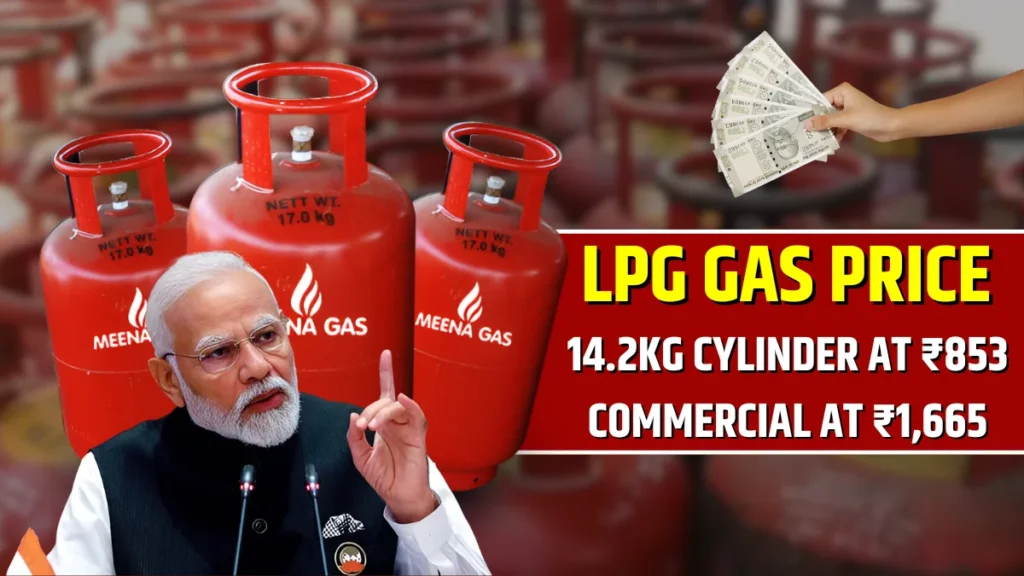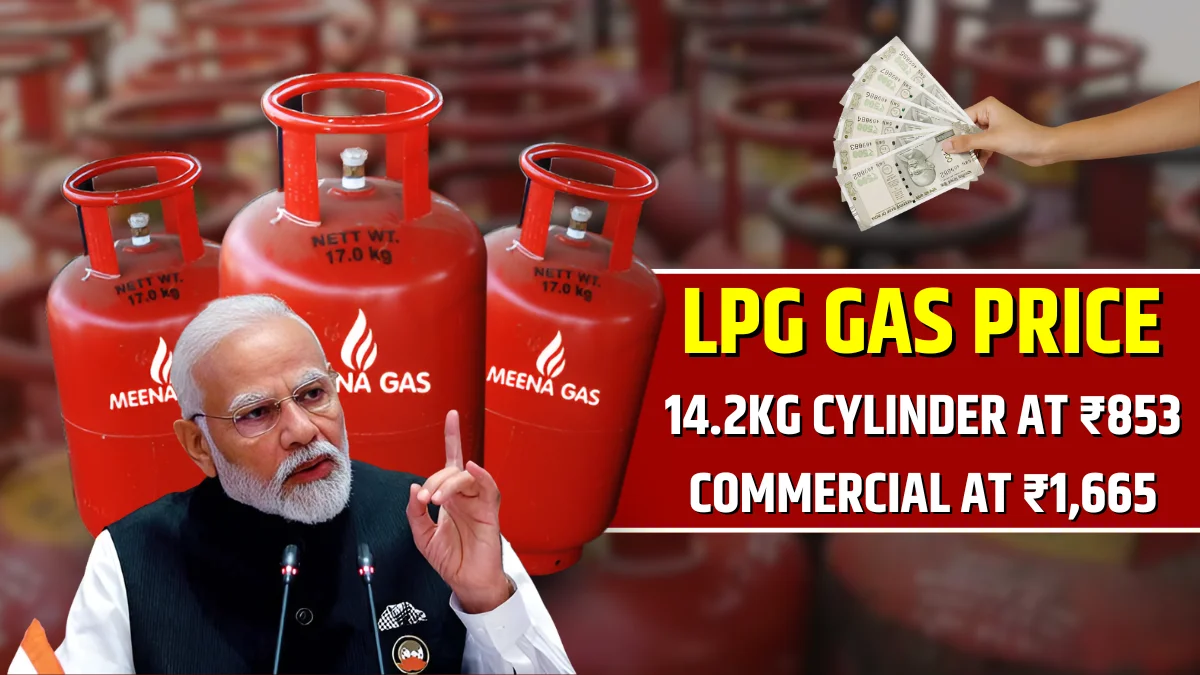LPG Gas Price – In today’s world, Liquefied Petroleum Gas (LPG) is an essential resource, used widely for cooking, heating, and even in some industrial applications. For millions of households, it is the primary fuel source for cooking.
However, the price of LPG has become a significant concern for many people, especially in India, where the cost of living and inflation continues to rise. Understanding LPG gas prices, the factors that influence them, and the distinction between domestic and commercial cylinders can help consumers navigate these challenges more effectively.

LPG Gas Price Breakdown: Domestic vs. Commercial
Currently, the price of a 14.2 kg domestic LPG cylinder is ₹853, while the commercial cylinder, typically 19 kg, costs ₹1,665. These two types of cylinders serve different purposes and cater to different customer bases, yet the price difference is substantial.
The domestic LPG cylinder, which is the smaller size, is predominantly used by households for cooking. This price is somewhat subsidized by the Indian government, with various policies aimed at making LPG more affordable for everyday consumers. On the other hand, the commercial LPG cylinder is intended for businesses like hotels, restaurants, and other establishments where gas is used in large quantities. The price for this type of cylinder is higher and is not subsidized, reflecting the market price for commercial users.
While the price difference between domestic and commercial LPG cylinders is apparent, it’s essential to understand the various factors that influence these prices.
Factors Influencing LPG Prices
The cost of LPG is shaped by multiple factors, ranging from international markets to local distribution challenges. Understanding these factors can help explain why prices fluctuate and how consumers can manage their consumption more effectively.
One of the primary factors influencing LPG prices is global oil prices. Since LPG is derived from crude oil and natural gas, any fluctuations in the price of crude oil have a direct impact on the cost of LPG. When global oil prices increase, it often results in a corresponding rise in LPG prices, and vice versa. This is particularly relevant in India, as the country imports a large portion of its oil and gas, making it vulnerable to global price trends.
Another crucial factor is the exchange rate, particularly the value of the Indian Rupee against the US Dollar. LPG is largely imported, and when the value of the rupee weakens against the dollar, it increases the cost of purchasing LPG from international suppliers. This, in turn, leads to higher prices for the end consumer.
Transportation and distribution costs also contribute significantly to LPG pricing. In India, LPG must be transported from refineries to local distributors, and this process can be expensive, especially when the delivery locations are in remote areas. The cost of transporting LPG is factored into the final price, which may vary depending on the region.
Government subsidies are another factor that impacts the pricing of domestic LPG cylinders. The Indian government has historically subsidized domestic LPG prices to make cooking fuel affordable for the general population. However, these subsidies are not unlimited and are subject to change based on government policies, the state of the economy, and global market conditions. When subsidies are reduced or phased out, consumers may notice an increase in LPG prices.
Finally, taxation plays a significant role in LPG pricing. The introduction of the Goods and Services Tax (GST) on LPG has added a layer of tax to the overall cost of the gas. While this tax is standardized, its effect on the final price can still be felt by consumers, especially those in rural areas who may face higher transportation costs.
The Difference Between Domestic and Commercial LPG Cylinders
While both domestic and commercial LPG cylinders are used for similar purposes, there are clear distinctions between them. The most noticeable difference is in their size. Domestic cylinders typically weigh 14.2 kg, while commercial cylinders often come in 19 kg or larger sizes. This difference in size means that commercial cylinders are designed to meet the higher demands of businesses that require more gas for cooking or other activities.
Another key difference is the pricing structure. Domestic LPG cylinders benefit from government subsidies, which help keep the price affordable for households. However, the subsidies are capped at a certain number of cylinders per year, after which consumers must pay the market price. In contrast, commercial cylinders are not subsidized by the government and are priced according to market rates. This makes them more expensive than domestic cylinders, though businesses that rely on LPG for cooking may find them more cost-effective in the long run.
The delivery process for commercial cylinders is also distinct. Due to their larger size and higher frequency of use, businesses typically require more regular deliveries of LPG. This means that commercial users often have larger storage tanks and more frequent refills, which can add to their overall cost.
Managing LPG Costs: What Can Consumers Do?
While consumers have limited control over the external factors that influence LPG prices, there are still several ways to manage and reduce their LPG consumption and overall costs.
One of the most effective ways to save on LPG costs is to use energy-efficient cooking appliances. Induction cookers, modern gas stoves with better heat retention, and pressure cookers can all help reduce the amount of gas used during cooking. By opting for more energy-efficient appliances, households can significantly reduce their gas consumption, which can translate into lower costs over time.
Proper storage and handling of LPG cylinders is another key consideration. LPG cylinders should be stored in a cool, dry place, away from heat sources and direct sunlight. Additionally, regular maintenance of LPG equipment, such as stoves and regulators, can help prevent leaks and ensure efficient gas usage.
For households that use LPG regularly, monitoring refill schedules is important. Running out of gas unexpectedly can lead to emergency refills, which are often priced higher. By keeping track of the cylinder’s usage and ordering refills in advance, consumers can avoid such situations and ensure they’re paying the standard price.
Finally, consumers can take advantage of government schemes and subsidies. The Pradhan Mantri Ujjwala Yojana, for example, offers free LPG connections to economically disadvantaged households, which helps ease the financial burden of purchasing a gas connection. Additionally, various state-level schemes may provide discounts or subsidies to specific groups, such as senior citizens or low-income families.
Conclusion
The price of LPG is influenced by a combination of global and local factors, including crude oil prices, exchange rates, transportation costs, and government subsidies. Understanding the differences between domestic and commercial LPG cylinders, and the elements that drive their prices, is crucial for consumers seeking to manage their gas expenses. While external factors often determine the price, consumers can take proactive steps to reduce their LPG consumption and make the most of available subsidies, ultimately helping to keep their costs manageable. By making informed choices about appliances, cylinder usage, and refills, both households and businesses can navigate the fluctuating LPG market with greater ease.
Disclaimer: The prices and information provided in this article are based on current market trends and may vary. For accurate and up-to-date pricing, please refer to your local LPG distributor.
